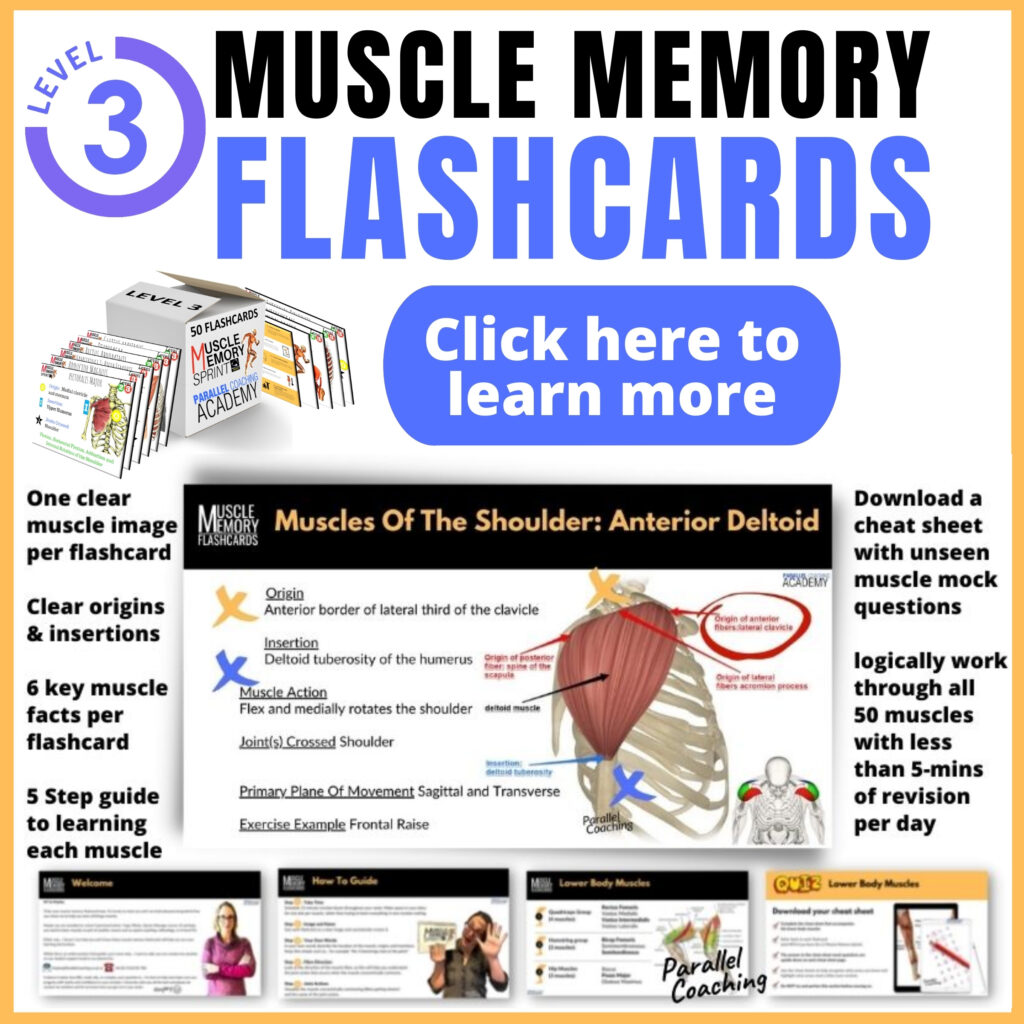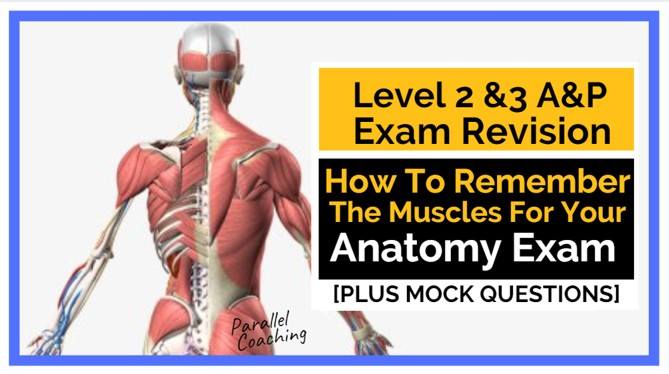In today’s blog, you’ll learn How to Remember the Muscles for Your L3 Anatomy Exam in 10 simple steps including a video tutorial
You’ll discover:
- Which muscles do you need to know for your anatomy exam
- What do you need to know about each muscle for the exam?
- 10 Steps: how to remember the muscles for your anatomy exam
- 43-minute video tutorial about muscles
- Test your knowledge with 3 muscles Mock Questions and answers
- How to learn and remember the muscles for your exam
Before I share a super-easy 10-step method to remember Remember all 50 Muscles for Your L3 Anatomy Exam, let’s first understand which muscles you need to know and in how much detail
Which muscles do I need to know for my anatomy exam?
You need to know 26 muscles for the Level 2 Anatomy and Physiology Exam and 50 for the Level 3 Anatomy and Physiology Exam.
The 50 muscles that you need to know for your L3 Anatomy exam include:
- Hips and Core x 9 muscles
- Legs x 19 muscles
- Lower Back and Torso x 14 muscles
- Chest and Arms x 8 muscles
What do I need to know about each muscle for the exam?
For each of the muscles listed above you need to know 5 things for each muscle:
- the location,
- the origin,
- the insertion,
- the joints crossed,
- the joint action created during concentric contraction
That could be as much as 250 pieces of information that you’d need to learn just about muscles, within the Level 3 Anatomy and Physiology Exam.
If you attempt to learn this without a system, there will be chaos and your brain will struggle to “file” the information correctly.
So, here’s a 10-step system to help you get organised and pass your exam with confidence:
The 10 Steps to remember the muscles for your anatomy exam
1) SCHEDULE
Get a list of all the muscles you need to know (this will be in your qual guidance or in your manual and will vary for different syllabi).
Work out how many 10 MINUTE SLOTS of revision you can schedule between now and your exam.
Divide these slots into each of the muscles – allocating a clear 10-minute window dedicated to each muscle on your list.
2) THE BASICS
Get a clear image of the muscle you are working on and look at it (you need to be able to see the origin and insertion)
3) NAME IT
Write the NAME OF THE MUSCLE, on a post-it note (correctly and clearly).
4) IMAGINE
In your mind’s eye, picture this word being tattooed onto the muscle image
5) VISUALISE
Close your eyes – can you SEE THE MUSCLE with the name written on it? If not, look at the image and the word more, really focus on it, and then test yourself again.
6) ORIGIN and INSERTION
Now write the ORIGIN of the muscle above the name on the post-it note and the INSERTION below the name.
TIP: The origin is usually the attachment close to the heart (except for some muscles of the torso)
7) IMAGINE
Now IMAGINE this being tattooed onto the image as well. really focus on it.
8) VISUALISE
Close your eyes, you should be able to SEE THE WORDS for the name of the muscle, the origin and the insertion written clearly over the clear muscle image.
9) ACTION
Do an action/ EXERCISE that uses this muscle. Feel it working
10) REST
YOU ARE DONE. leave muscles for a bit and go onto another topic/ task.
Test your knowledge with 3 Muscles Mock Questions
Look at the 3 Muscles Mock questions below and jot down your answer on scrap paper or as a note on your phone.
Then scroll down to reveal the answers.
1) Where does the Pectoralis Major Insert?
A. Humerus
B. Sternum
C. 5th-10th Rib
D. Thoracic Vertebrae
2) What is the Origin of the Biceps Femoris?
A. Pubis
B. Ischium
C. Anterior Superior Iliac Spine
D. Femur
3) What is the Insertion of the Semitendinosus?
A. Tibia
B. Fibula
C. Ischium
D. Femur
Answers:
Q1: Answer = A
Q2: Answer = B
Q3: Answer = A
If you want more mock questions like this, then you can download more Free Mock Questions: DOWNLOAD NOW
How to learn origins and insertions?
Learn, Revise & Remember All 50 Muscles In The Level 3 Anatomy & Physiology Exam.
(and the BEST part…You can do all this in as little as 5-minutes a day)
Each flashcard gives you a clear image and six clear muscle facts:
- Name and Location
- Origin and Insertions
- Muscle Actions
- Joints Crossed
- Primary Planes Of Movement
- Exercise Examples

Dedicated to More
Hayley “Remember the Muscles for Your Anatomy Exam” Bergman
Parallel Coaching
P.S. You can also find us on the following platforms:
Instagram: Follow Now
Facebook: Like Our Page
Twitter: Tweet Us
YouTube: Subscribe Here
More Muscle Revision Blogs: HERE

